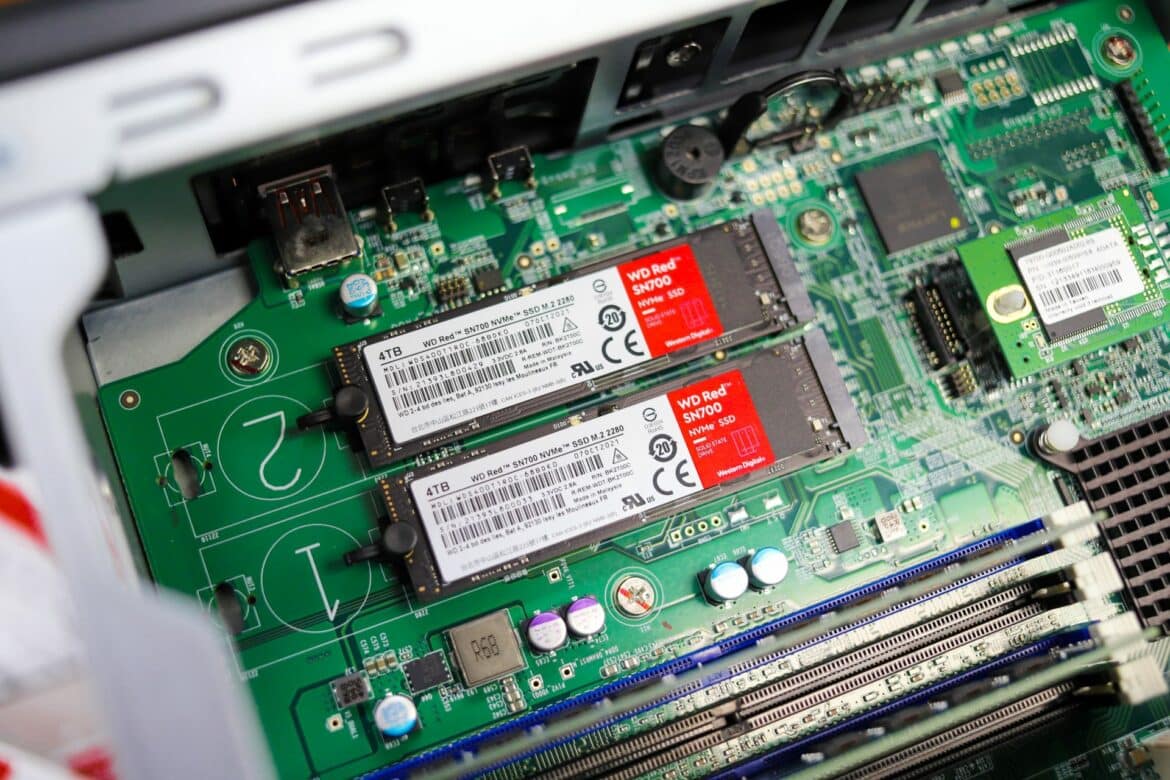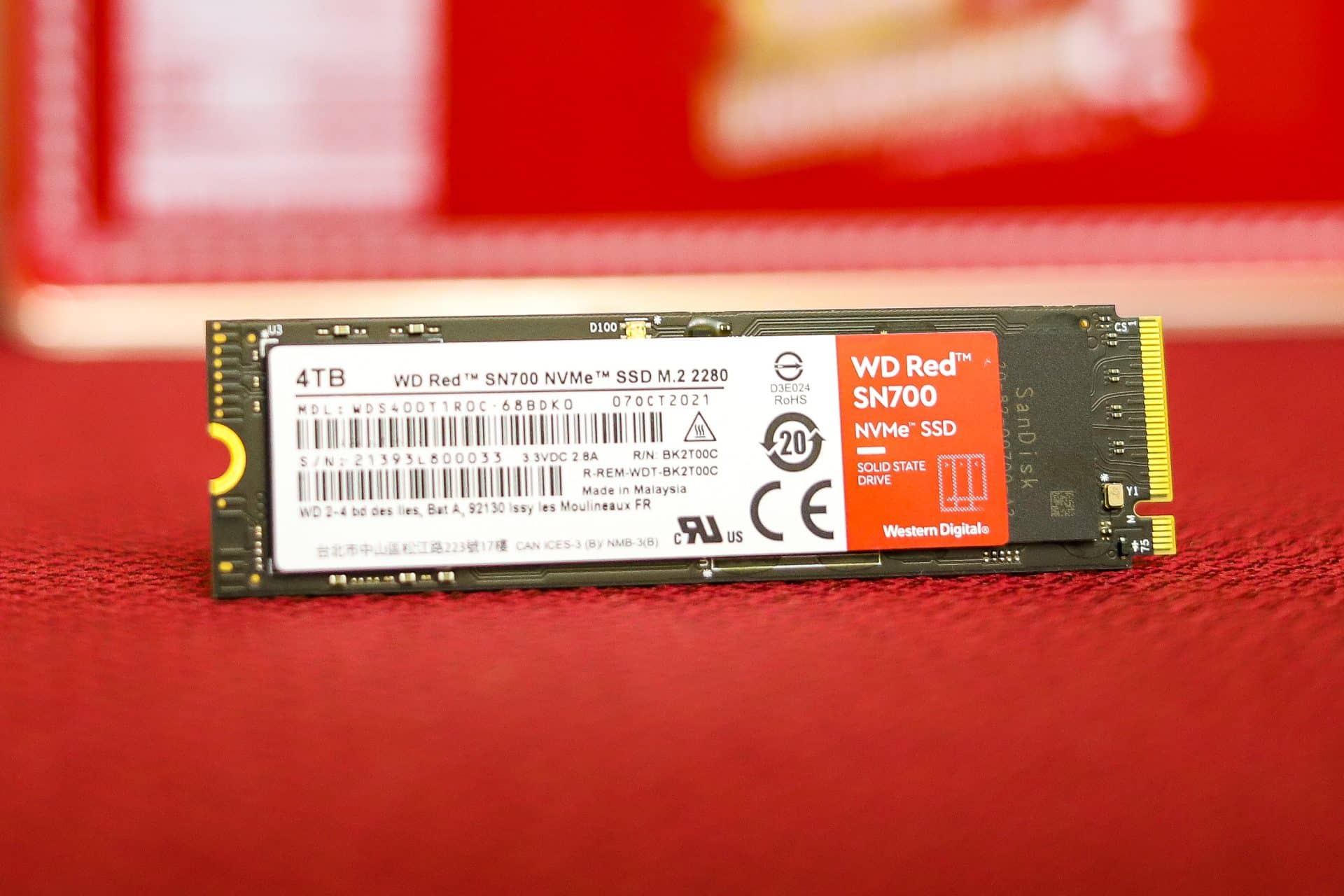Western Digital has recently sent the all-new WD Red SN700 for us to review. This new drive was recently added to their line-up and was designed for high endurance, caching driving that helps accelerate NAS performance. WD built this drive with the idea in mind to support NAS environments 24/7 with applications always running. This drive was made for reliability and endurance up to 5,100 TBW (4TB model).
Western Digital has recently sent the all-new WD Red SN700 for us to review. This new drive was recently added to their line-up and was designed for high endurance, caching driving that helps accelerate NAS performance. WD built this drive with the idea in mind to support NAS environments 24/7 with applications always running. This drive was made for reliability and endurance up to 5,100 TBW (4TB model).
WD Red SN700
The WD Red SN700 is also highlighted by its fast system responsiveness and I/O performance, which is ideal for multi-user, multi-application use cases. Western Digital also claims that this drive will be able to “tame” the toughest SMBs projects. Meaning that it will be able to support anything from virtualization, collaborative editing, all the way to intensive database storage. WD also states that by adding the SN700, because of the caching on the device, it will easily handle multiple random workloads at once. 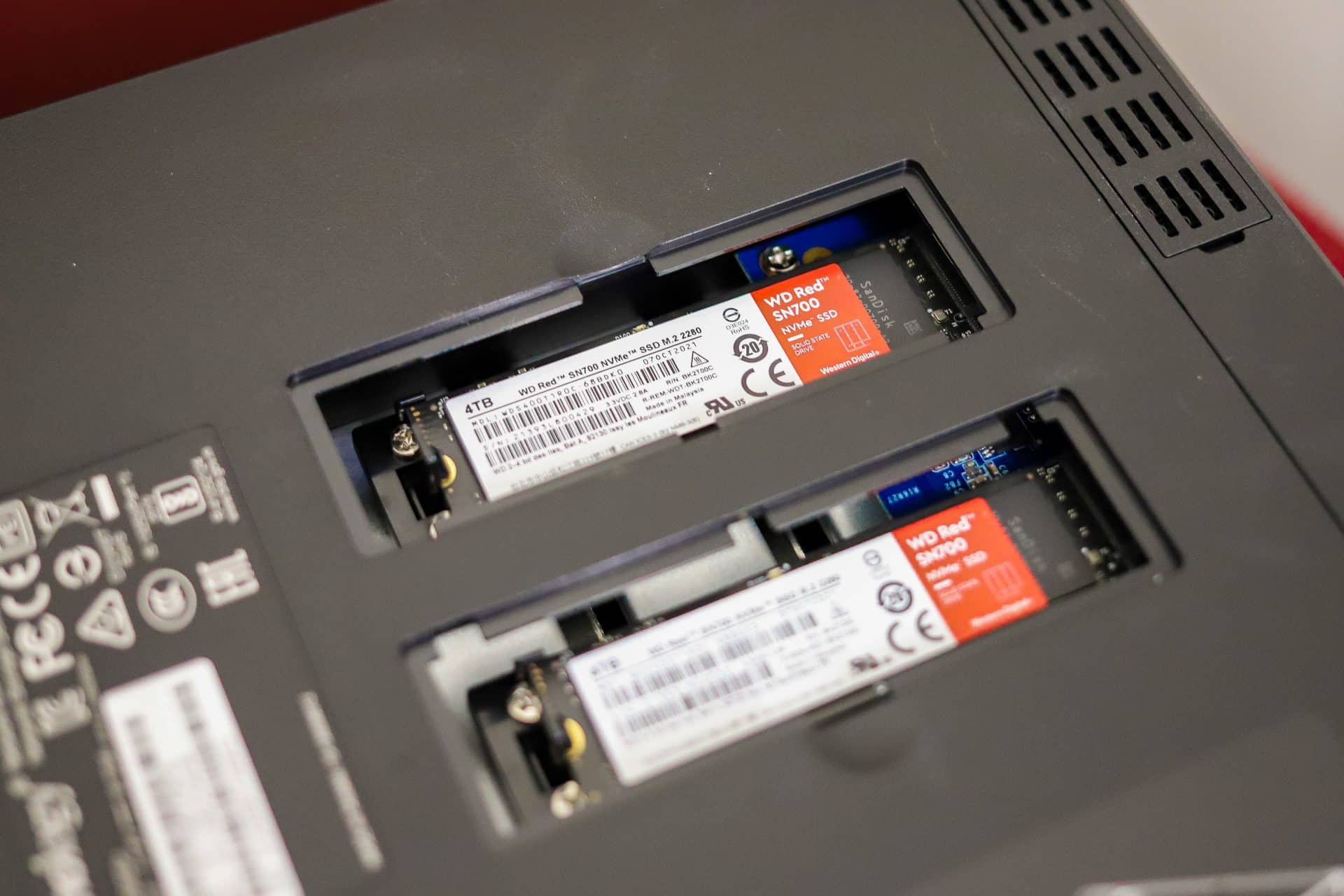
Systems from QNAP, Synology, and others that have NVMe acceleration bays or cards, will be able to take advantage of this new NVMe SSD. As seen in the picture above, many NAS models like Synology have easy-to-access cache drive bays on the bottom of the NAS. QNAP’s slots tend to be internal, as seen below. Not all M.2 slots are NVMe yet, however, so be sure to check with your NAS vendor before paying the NVMe premium when compared to SATA.
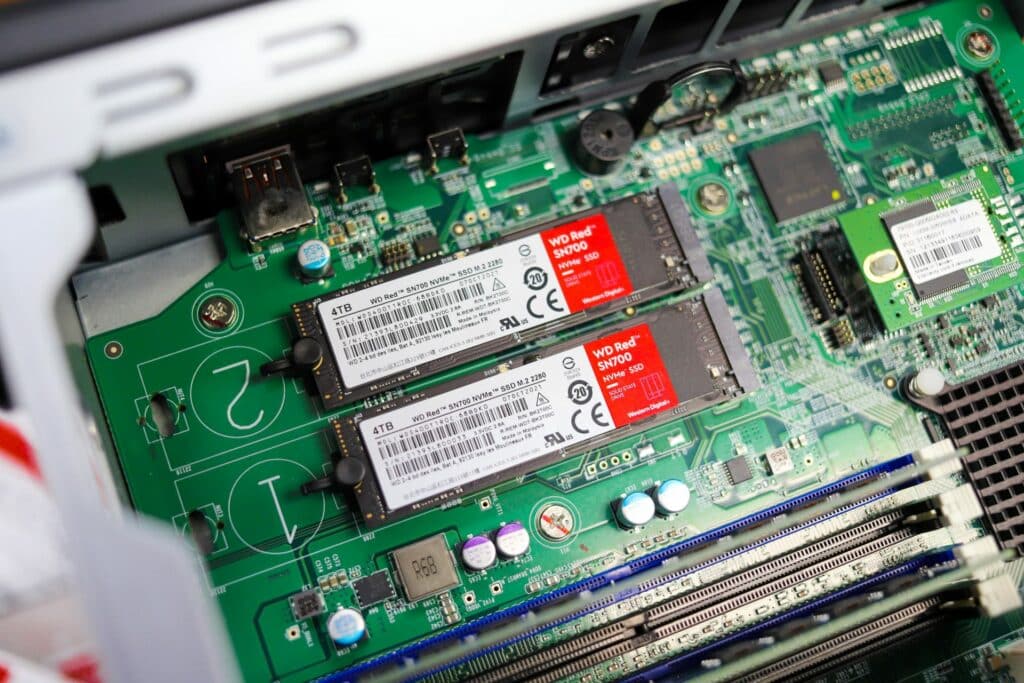
WD adds the SN700 (4TB) to their new WD Red portfolio of storage solutions. Other drives in this portfolio include the WD Red Pro HDDs, WD Red SATA SSDs, WD Red Plus, and a few others. The drive that was sent to us was the maximum capacity WD Red SN700 drive at 4TB. However, WD also offers the SN700 in 250GB, 500GB, 1TB, and 2TB. The 4TB model, along with the others, is now available from Amazon and select other distributors. The prices range from $79.99 for the 500GB drive up to $479.99 for the 4TB SN700 under review.
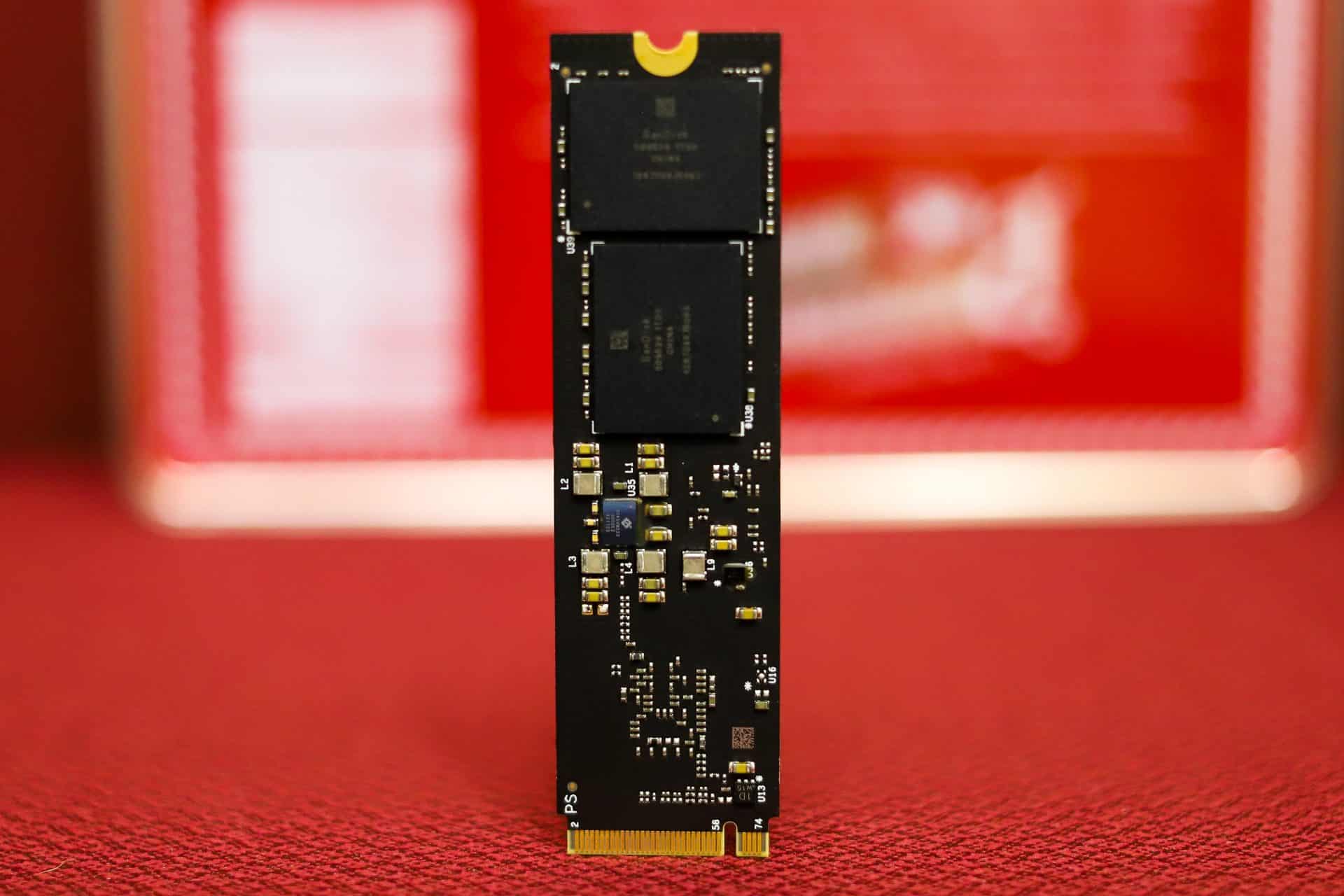
WD Red SN700 NVMe SSD Specifications
| Capacites | 250GB | 500GB | 1TB | 2TB | 4TB |
| Form Factor | M.2 2280-S3-M | M.2 2280-S3-M | M.2 2280-S3-M | M.2 2280-S3-M | M.2 2280-S3-M |
| Interface | PCIe Gen3 8 Gb/s, up to 4 Lanes | PCIe Gen3 8 Gb/s, up to 4 Lanes | PCIe Gen3 8 Gb/s, up to 4 Lanes | PCIe Gen3 8 Gb/s, up to 4 Lanes | PCIe Gen3 8 Gb/s, up to 4 Lanes |
| Peak Power (10μs) | 2.8A | 2.8A | 2.8A | 2.8A | 2.8A |
| Operation Temperature | 32ºF to 158ºF
(0ºC to 70ºC) |
32ºF to 158ºF
(0ºC to 70ºC) |
32ºF to 158ºF
(0ºC to 70ºC) |
32ºF to 158ºF
(0ºC to 70ºC) |
32ºF to 158ºF
(0ºC to 70ºC) |
| Non-Operating Temperature | 67ºF to 185ºF
(-55ºC to 85ºC) |
67ºF to 185ºF
(-55ºC to 85ºC) |
67ºF to 185ºF
(-55ºC to 85ºC) |
67ºF to 185ºF
(-55ºC to 85ºC) |
67ºF to 185ºF
(-55ºC to 85ºC) |
| Performance | Sequential Read: 3,100(MB/s)
Sequential Write: 1,600(MB/s) Random Read: 220K IOPS Random Write: 180K IOPS |
Sequential Read: 3,430(MB/s)
Sequential Write: 2,600(MB/s) Random Read: 420K IOPS Random Write: 380K IOPS |
Sequential Read: 3,430(MB/s)
Sequential Write: 3,000(MB/s) Random Read: 515K IOPS Random Write: 560K IOPS |
Sequential Read: 3,400(MB/s)
Sequential Write: 2,900(MB/s) Random Read: 480K IOPS Random Write: 540K IOPS |
Sequential Read: 3,400(MB/s)
Sequential Write: 3,100(MB/s) Random Read: 550K IOPS Random Write: 520K IOPS |
| Weight | 7.5g | 7.5g | 7.5g | 7.5g | 7.5g |
| Dimensions | 80x22x2.4mm | 80x22x2.4mm | 80x22x2.4mm | 80x22x2.4mm | 80x22x2.4mm |
| Certifications | FCC, UL, TUV, KCC, BSMI, VCCI, C-Tick | FCC, UL, TUV, KCC, BSMI, VCCI, C-Tick | FCC, UL, TUV, KCC, BSMI, VCCI, C-Tick | FCC, UL, TUV, KCC, BSMI, VCCI, C-Tick | FCC, UL, TUV, KCC, BSMI, VCCI, C-Tick |
| MTTF (hours) | 1,750,000 | 1,750,000 | 1,750,000 | 1,750,000 | 1,750,000 |
| Limited Warranty | 5 years | 5 years | 5 years | 5 years | 5 years |
WD Red SN700 Performance
Testbed
As we migrate into testing newer NVMe Gen4 SSDs, it required a platform shift in our lab to support the newer interface. We’ve also been migrating newer NVMe Gen3 SSDs to the same platform for better apples-to-apples comparisons between drive generations. For these reviews, we leverage the Lenovo ThinkSystem SR635 server, equipped with an AMD 7742 CPU and 512GB of 3200Mhz DDR4 memory.
NVMe is tested natively through an M.2 to PCIe adapter card in the edge-card slot, while U.2 drives are loaded in the front. The methodology used better reflects end-user workflow with the consistency, scalability, and flexibility testing within virtualized server offers. A large focus is put on drive latency across the entire load range of the drive, not just at the smallest QD1 (Queue-Depth 1) levels. We do this because many of the common consumer benchmarks don’t adequately capture end-user workload profiles.
vdBench Workload Analysis
When it comes to benchmarking storage devices, application testing is best, and synthetic testing comes in second place. While not a perfect representation of actual workloads, synthetic tests do help to baseline storage devices with a repeatability factor that makes it easy to do apples-to-apples comparisons between competing solutions. These workloads offer a range of different testing profiles ranging from “four corners” tests, common database transfer size tests, to trace captures from different VDI environments.
All of these tests leverage the common vdBench workload generator, with a scripting engine to automate and capture results over a large compute testing cluster. This allows us to repeat the same workloads across a wide range of storage devices, including flash arrays and individual storage devices. Our testing process for these benchmarks fills the entire drive surface with data, then partitions a drive section equal to 5% of the drive capacity to simulate how the drive might respond to application workloads. This is different from full entropy tests which use 100% of the drive and take them into a steady state. As a result, these figures will reflect higher-sustained write speeds.
Profiles:
- 4K Random Read: 100% Read, 128 threads, 0-120% iorate
- 4K Random Write: 100% Write, 64 threads, 0-120% iorate
- 64K Sequential Read: 100% Read, 16 threads, 0-120% iorate
- 64K Sequential Write: 100% Write, 8 threads, 0-120% iorate
- Synthetic Database: SQL and Oracle
- VDI Full Clone and Linked Clone Traces
Comparables:
First up is our random 4K read. Here, the WD Red SN700 peaked at 492,039 IOPS with a latency of 258µs, which placed it first overall, beating out the Seagate IronWolf 525.
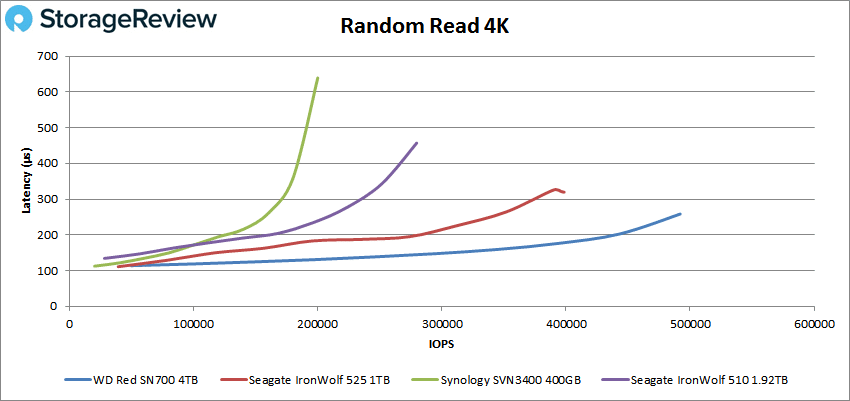
In 4K write, the SN700 started at a very low latency, similar to the other drives, then went on to peak at just over 70,177 IOPS with a latency at 1,818µs.
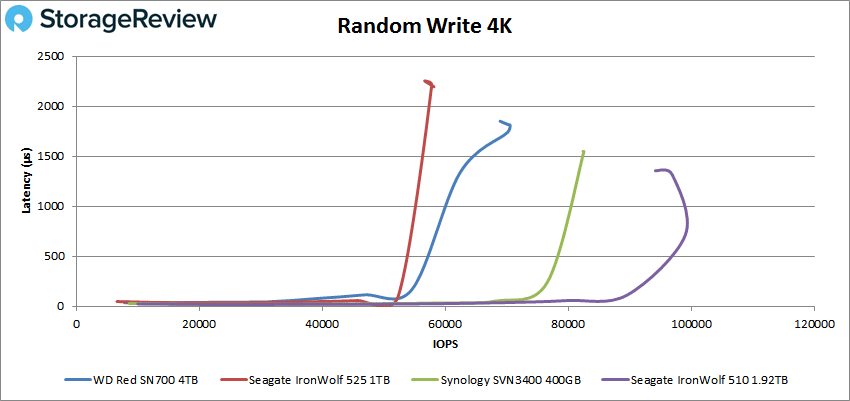
Switching over to sequential workloads, the new SN700 drive had higher IOPS than the Synology SVN3400-400GB and the Seagate IronWold 510 1.92TB. Here, the SN700 had sub-millisecond latency performance throughout with a peak of 2,850MB/s and 692µs latency, placing it first in MB/s by a large margin.
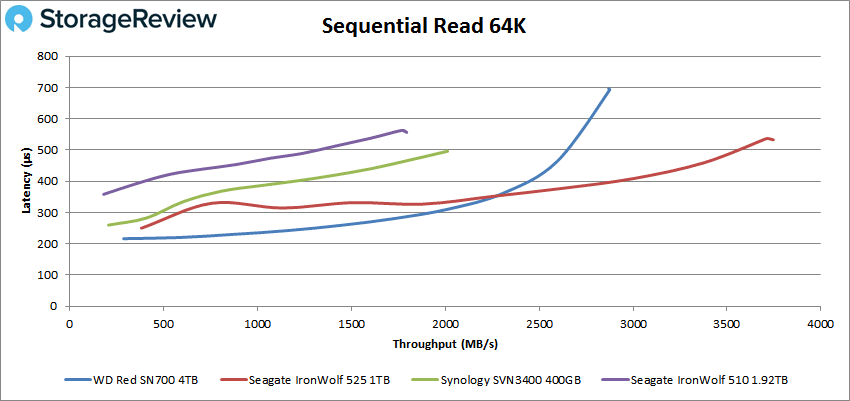
On the sequential write, the SN700 performed with higher MB/s than the comparables. The drive peaks at 500MB/s and 214µs latency, placing it in comparison with the comparables.
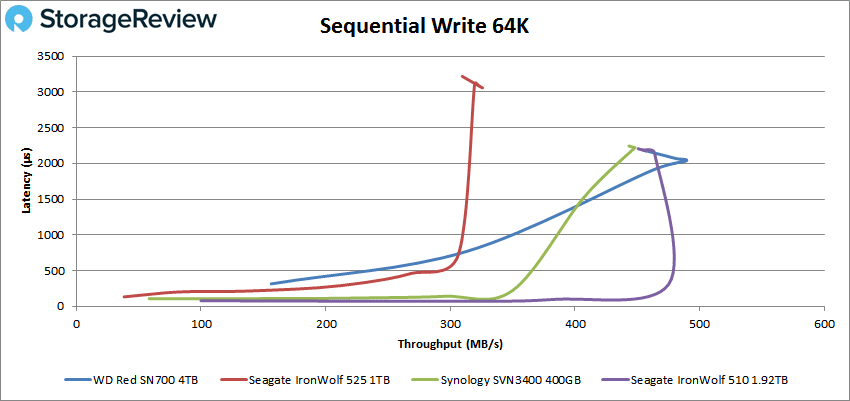
Next, we move on to our SQL workloads, where all the drives were behind the SN700. That said, the SN700 had a peak of 161,874 IOPS with a latency of 197µs in the SQL workload. The IronWolf 525 drive had over 123,829 IOPS and 257µs in latency for comparison.
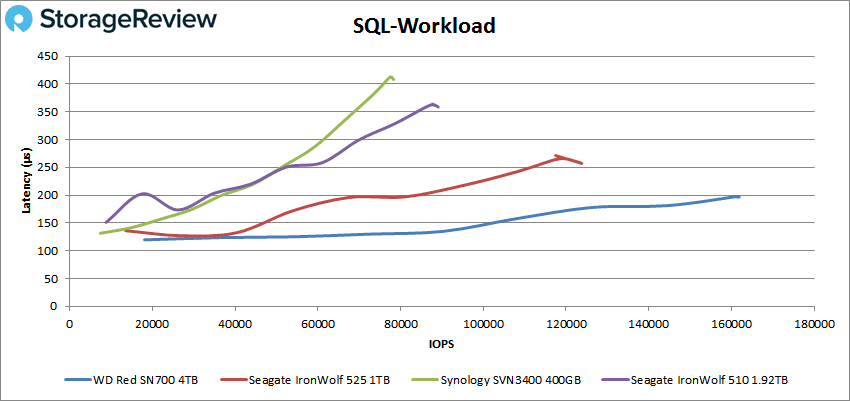
For SQL 90-10, the SN700 peaked at 126,886 IOPS with a latency of 245µs. Again, the IronWolf 525 drive had a performance not even close to the SN700.
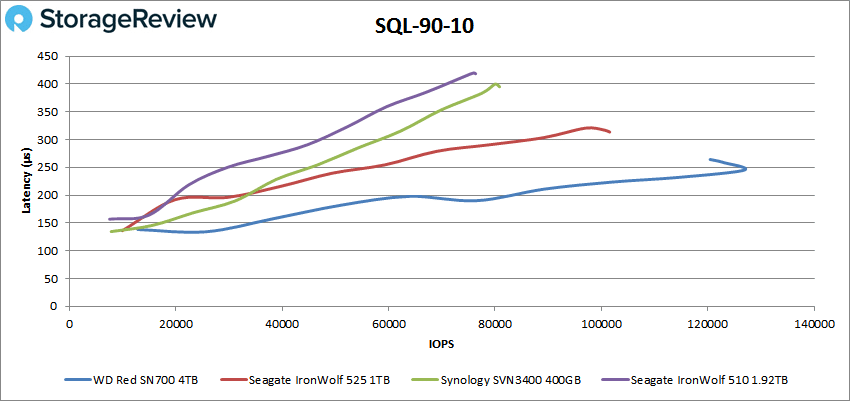
With the SQL 80-20, we see SN700 drive hit a peak of 99,552 IOPS with a latency of 320µs.
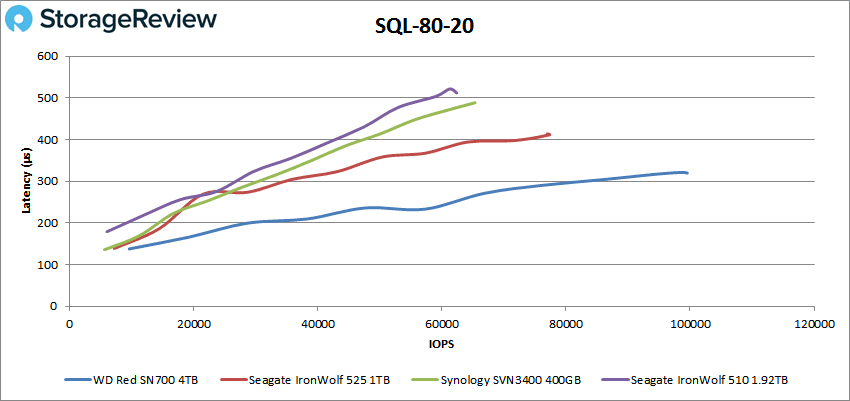
Moving on to our Oracle Workloads, the WD Red SN700 continued with a very low latency throughout the tests. For the Oracle workload profile, the drive peaked at 85,423 IOPS with a latency of 418µs.
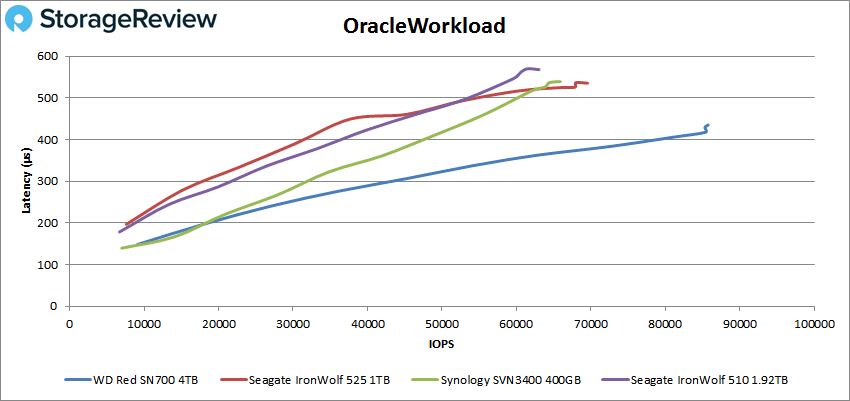
In the Oracle 90-10, we saw the SN700 hit a peak of 111,136 IOPS at 197µs latency. Again, the closest drive in performance was the IronWolf 525, but it didn’t even come close to the IOPS that the SN700 had with only 86,000 IOPS.
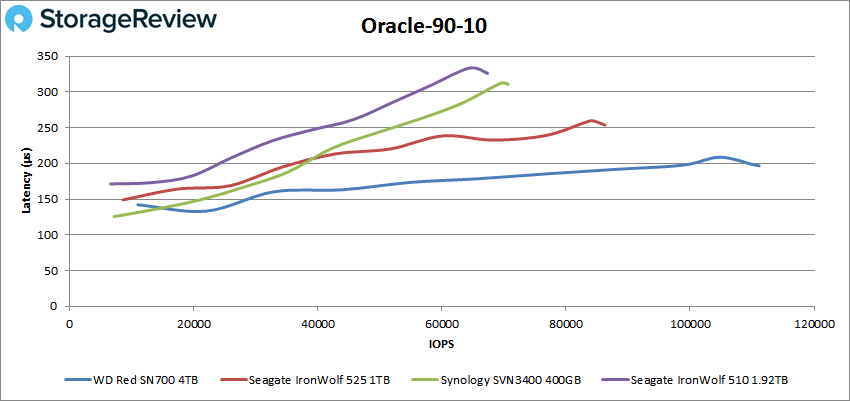
Oracle 80-20 saw the SN700 peak at 86,304 IOPS at 253µs for latency.
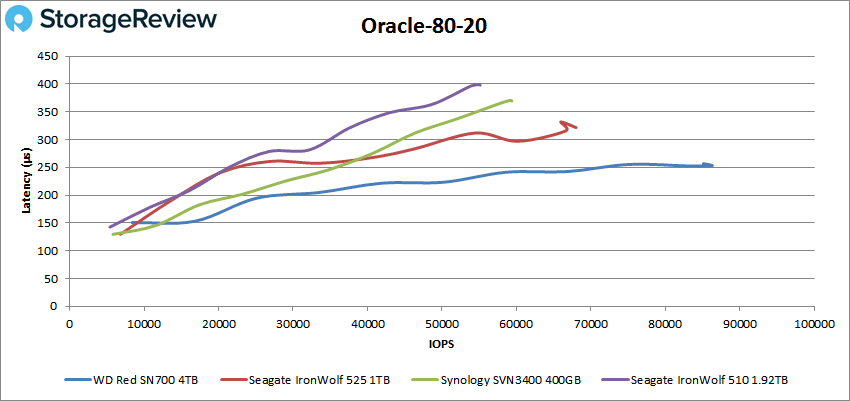
Now, we switched over to our VDI clone tests, Full and Linked. For VDI Full Clone Boot, the SN700 peaked at 104,207 IOPS at a latency of 319µs just before dropping off slightly.
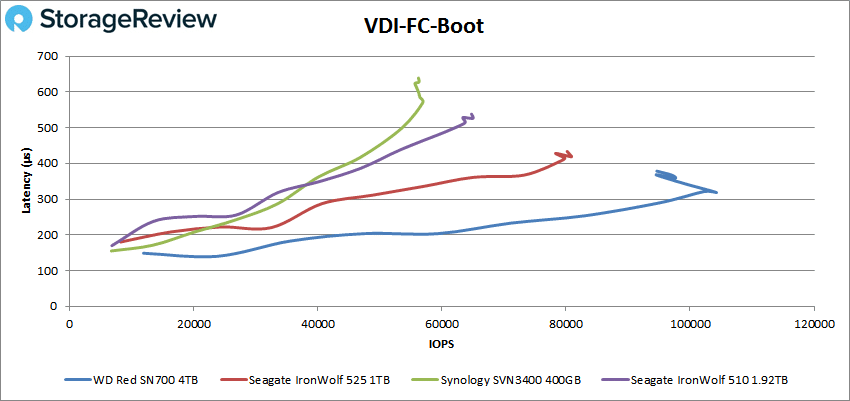 For VDI FC Initial Login, we saw the SN700 performance drop off slightly compared to the Synology SVN3400, with the SN700 peaking at 20,405 IOPS at 1465µs.
For VDI FC Initial Login, we saw the SN700 performance drop off slightly compared to the Synology SVN3400, with the SN700 peaking at 20,405 IOPS at 1465µs.
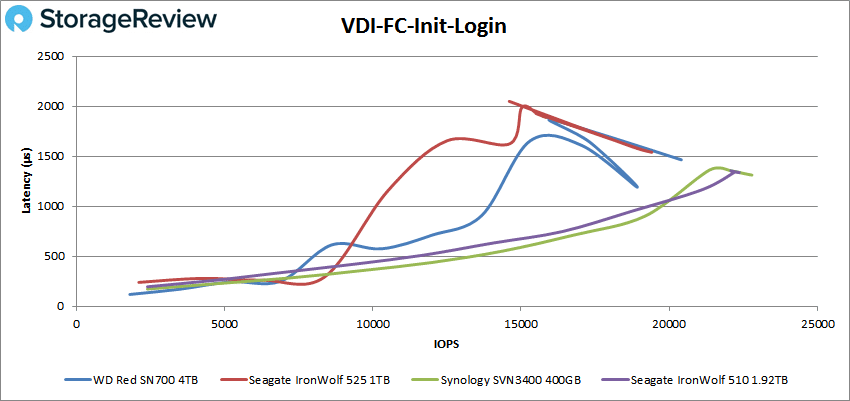
With the VDI FC Monday Login, the WD Red SN700 showed similar results on the IOPS side drive to the Synology SVN3400. With the SN700 posting a peak of 19,550 IOPS at 630µs, while the SVN3400 peaked at 20,933 IOPS.
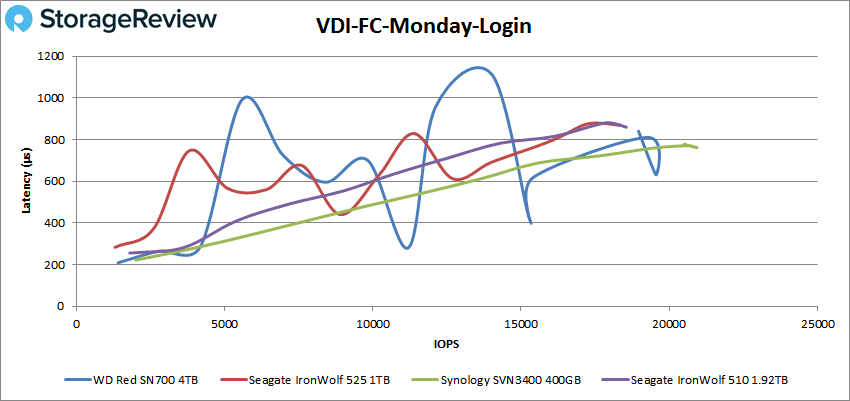
Moving onto the VDI Linked Clone Boot test, the SN700 peaked at 46,842 IOPS with a latency of 263µs.
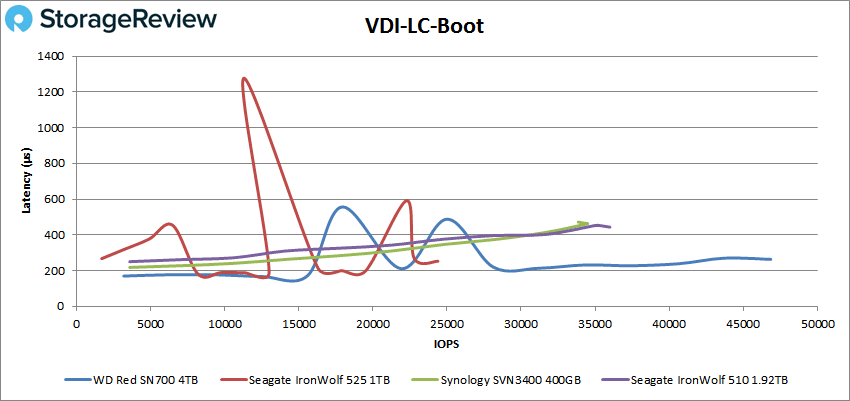
In the VDI LC Initial Login test, we saw the SN700 peak at 10,335 IOPS at 618µs latency before having a major drop off.
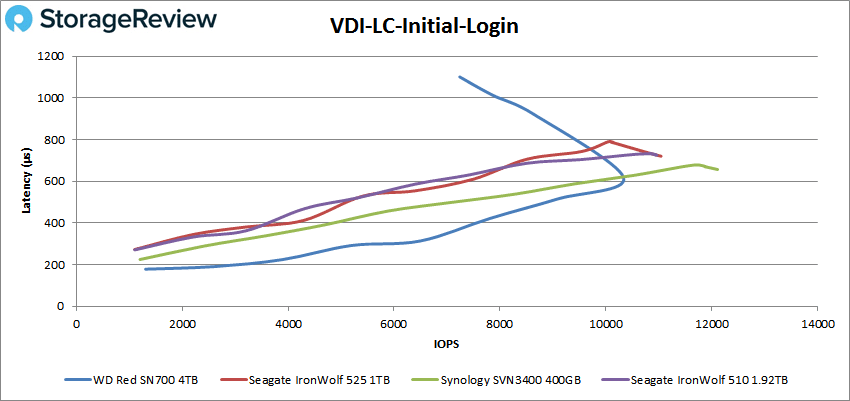
Finally, the VDI LC Monday Login, the SN700 showed worse performance than the comparables, ending with a peak of 8440 IOPS and a latency of 1653µs.
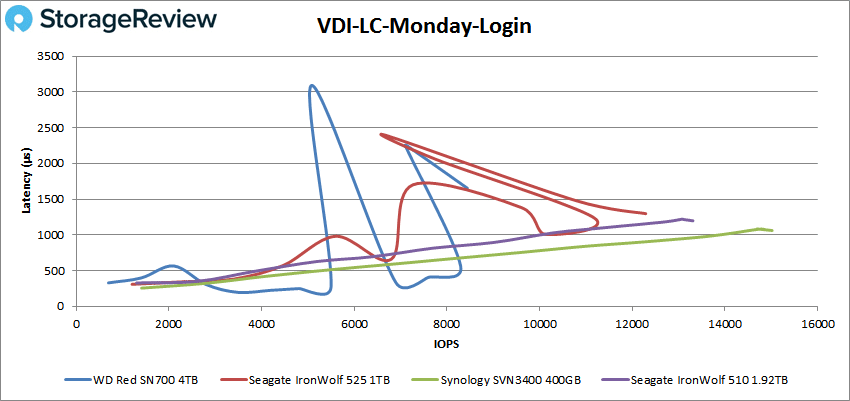
Enterprise Synthetic Workload Analysis
To measure the performance of the WD Red SN700 in a more real-world scenario we loaded two of the 4TB NVMe SSDs into a QNAP TVS-h1288x NAS running the QTS OS. We then made a RAID1 disk group on the two SSDs to provision a volume for SMB shares and iSCSI LUNs. The purpose of these tests are to show more real-world conditions, including the aspect that network connectivity will play a bigger role than NVMe interface for the primary bottleneck.
Our enterprise shared storage and hard drive benchmark process preconditions each drive into steady-state with the same workload the device will be tested with under a heavy load of 16 threads with an outstanding queue of 16 per thread, and then tested in set intervals in multiple thread/queue depth profiles to show performance under light and heavy usage. Since NAS solutions reach their rated performance level very quickly, we only graph out the main sections of each test.
Preconditioning and Primary Steady-State Tests:
- Throughput (Read+Write IOPS Aggregate)
- Average Latency (Read+Write Latency Averaged Together)
- Max Latency (Peak Read or Write Latency)
- Latency Standard Deviation (Read+Write Standard Deviation Averaged Together)
Our Enterprise Synthetic Workload Analysis includes four profiles based on real-world tasks. These profiles have been developed to make it easier to compare to our past benchmarks as well as widely-published values such as max 4k read and write speed and 8k 70/30, which is commonly used for enterprise drives.
- 4K
- 100% Read or 100% Write
- 100% 4K
- 8K 70/30
- 70% Read, 30% Write
- 100% 8K
- 8K (Sequential)
- 100% Read or 100% Write
- 100% 8K
128K (Sequential)
- 100% Read or 100% Write
First up are the enterprise workloads, where we measure a long sample of random 4K performance with 100% write and 100% read activity. For IOPS, the drive gave us SMB speeds of 94,245 read IOPS and 89,548 write IOPS. iSCSI gave us 289,930 read IOPS and 279,774 write IOPS.
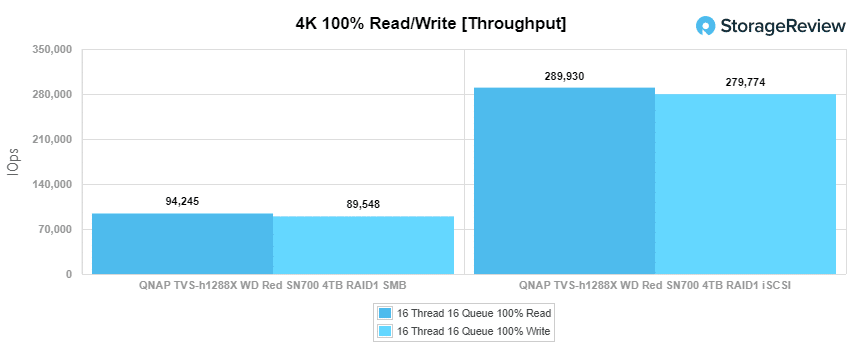
For 4K average latency, SMB saw 2.71ms read and 2.86ms write, while iSCSI was 0.88ms read and 0.91ms write.
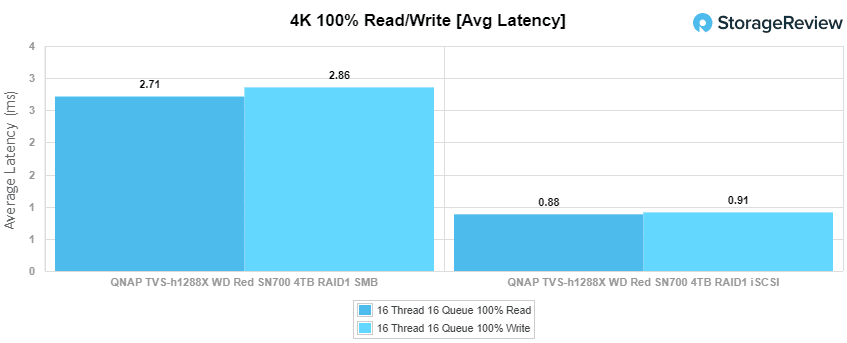
Max latency with 4K had SMB measured 10.9ms read and 10ms write and iSCSI of 2,542ms read and 91.3ms write.
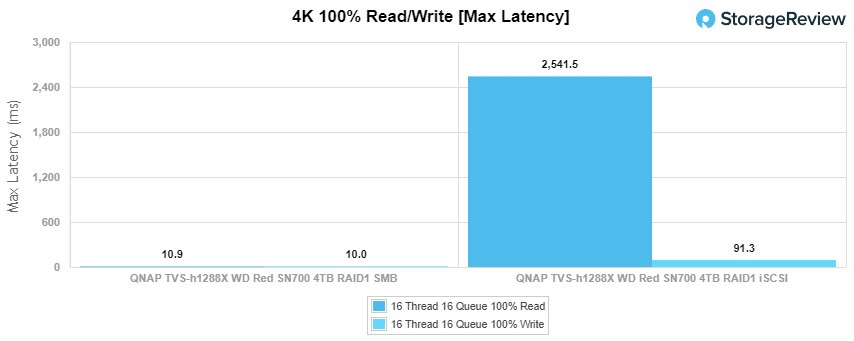
Our last 4K test was a standard deviation that gave us 1.87ms read and 2.5ms write in SMB and 4.06ms read and 1.18ms write in iSCSI.
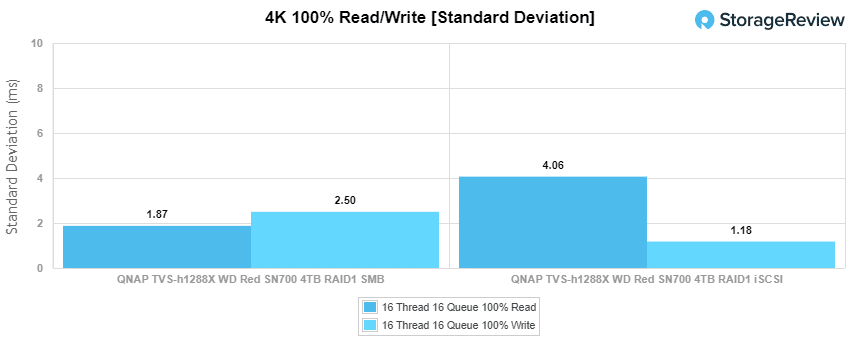
Our next benchmark measures 100% 8K sequential throughout with a 16 Thread 16 Queue load in 100% read and 100% write. Here, the Red SN700 was able to hit 122,844 IOPS read and 86,345 IOPS write in SMB as well as 219,371 IOPS read and 209,527 IOPS write in iSCSI.
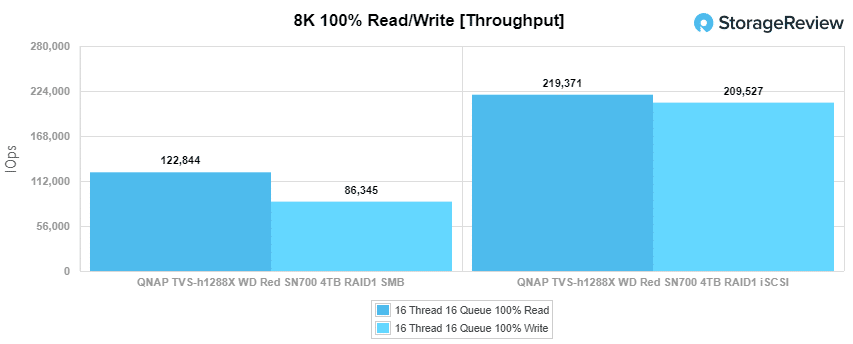
Compared to the fixed 16 thread, 16 queue max workload we performed in the 100% 4K write test, our mixed workload profiles scale the performance across a wide range of thread/queue combinations. In these tests, we span workload intensity from 2 thread/2 queue up to 16 thread/16 queues. In throughput, the SN700 was fairly flat in SMB starting at 13,750 IOPS and ending at 38,500 IOPS. There was a big improvement from beginning to end in iSCSI with a start of 13,750 IOPS and an end at 193,000 IOPS.
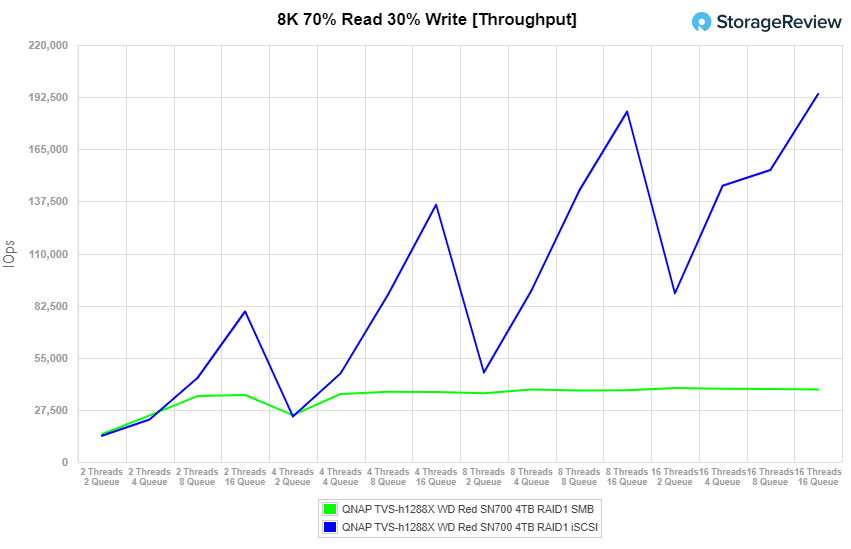
For 8K 70/30 average latency, the SMB configuration started at 0.12ms and spiked up to 7.5ms at the end. The iSCSI started at 0.12ms and finished at a much milder 1.5ms.
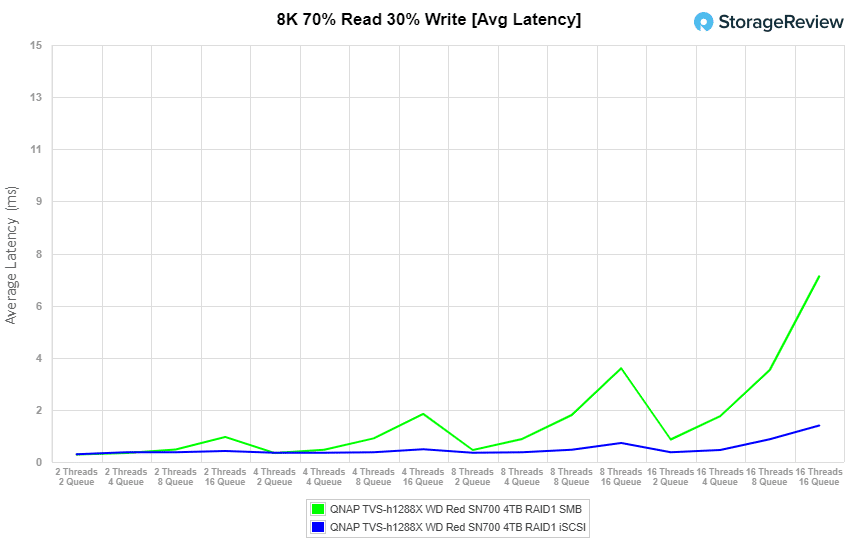
With 8K 70/30 max latency, the SMB test went from 25ms to 27ms and iSCSI went from 26ms to 600ms.
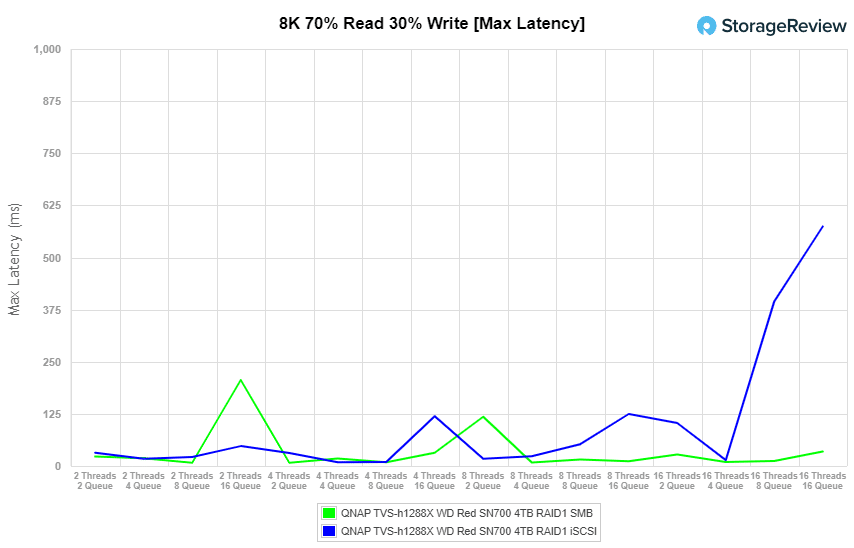
8K 70/30 standard deviation saw latency go from 0.1ms to 0.7ms in SMB and 0.1ms to 2ms in iSCSI.
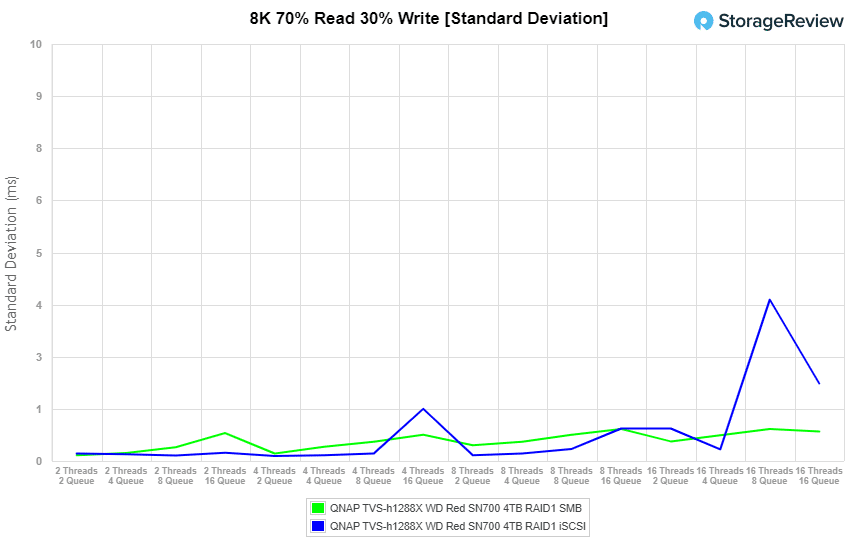
The last synthetic benchmark is our 128K test, which is a large-block sequential test that shows the highest sequential transfer speed for a device. In this workload scenario, the SMB configuration saw speeds of 2.3GB/s read and 2.3GB/s write while iSCSI saw speeds of 1.9GB/s read and 2.3GB/s write.
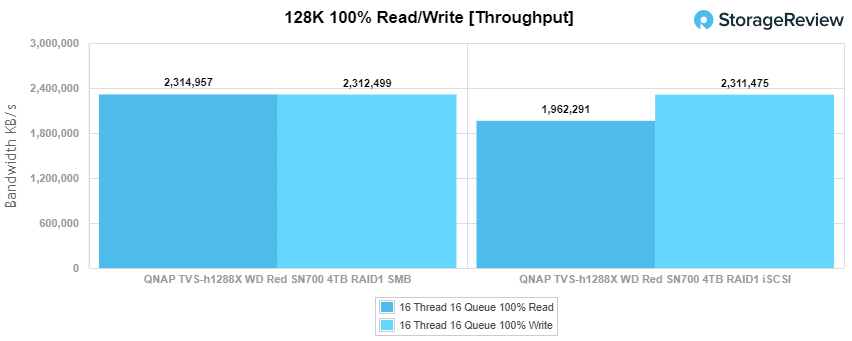
Conclusion
The WD Red SN700 is the newest SSD to come to the WD Red line-up. The drive was designed to accelerate a NAS with robust system responsiveness and exceptional I/O performance. For performance, we ran VDBench and Enterprise tests. The SN700 showed pretty solid results, placing first in nearly every test compared to the other drives that we benchmarked along with it in this category. WD brought a lot to the table with the SN700 and showed it didn’t need the Gen4 interface yet for its intended use case.
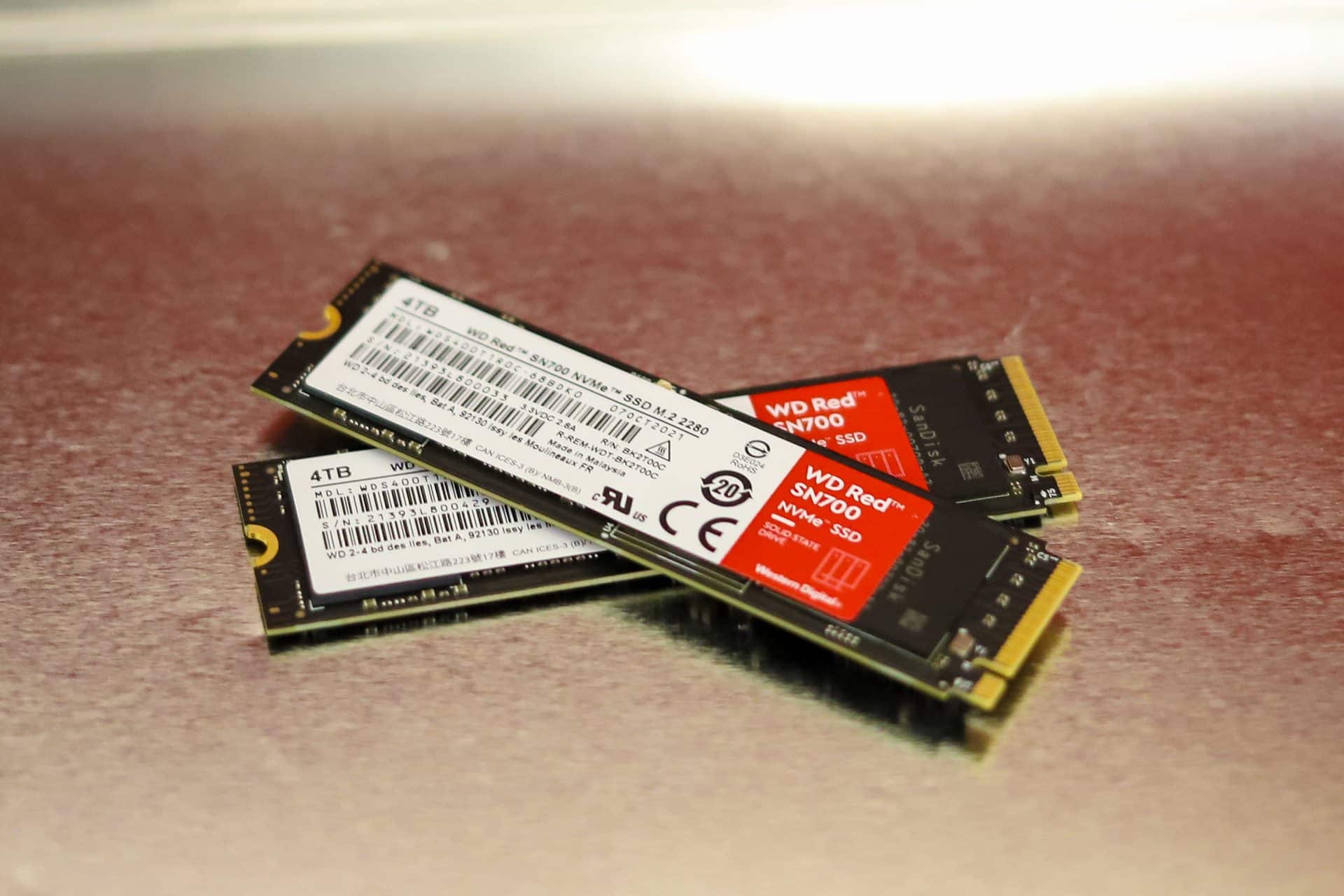
Looking at peak VDBench metrics, the SN700 recorded 492,039 IOPS in 4K read, 70,177 IOPS in 4K write, 2,850MB/s in 64K read, and 500MB/s in 64K write. When we switched over to our SQL workloads, we saw a peak of 161,874 IOPS in the workload test, 126,886 IOPS in the 90-10, and 99,552 IOPS in 80-20. Next was our Oracle tests, and in this we peaked at 85,423 IOPS in our workload, 111,136 IOPS in the 90-10, and 86,304 in the 80-20. In our VDI FC tests, the drive hit 104,207 IOPS in boot, 20,405 IOPS in Initial Login, and 19,550 IOPS in Monday Login. For our VDI LC tests, the SN700 peaked at 46,842 IOPS in boot, 10,335 IOPS in Initial Login, and 8,440 IOPS in Monday Login.
The next tests that we performed were using the Red SN700 for shared storage inside a QNAP TNS-h1288x NAS in RAID1. For SMB configuration, we saw 4K throughput of 94,245 IOPS read and 89,548 IOPS write, 4K average latency of 2.71ms read and 2.86ms write, 4K max latency of 10.9ms read and 10ms write, 8K sequential of 122,844 IOPS read and 86,345 IOPS write, and finally, in 128K large block, it tested at 2.3GB/s read and 2.3GB/s write in SMB. Next was our iSCSI configurations. we saw 4K throughput of 289,930 IOPS read and 279,774 IOPS write, 4K average latency of 0.88ms read and 0.91ms write, 4K max latency of 2,542ms read and 91.3ms write, 8K sequential of 219,371 IOPS read and 209,527 IOPS write, and finally was the 128K large block with 1.9GB/s read and 2.3GB/s write.
Overall, the WD Red SN700 is a solid choice when it comes to an SSD that can accelerate shared storage. This is important with use cases in mind like virtualization, database storage, concurrent access, and collaborative editing. The SN700 would be a solid choice to put inside of an NVMe-capable NAS for caching, tiering, or dedicated storage needs.
WD Red SN700 NVMe SSD at Amazon
Engage with StorageReview
Newsletter | YouTube | Podcast iTunes/Spotify | Instagram | Twitter | Facebook | RSS Feed

